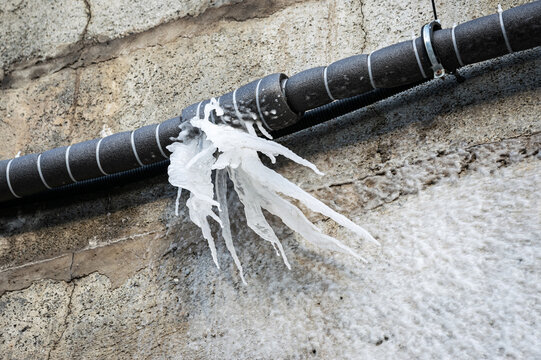Avoid Frozen Plumbing in Cold Weather: Pro Strategies
Avoid Frozen Plumbing in Cold Weather: Pro Strategies
Blog Article
We've stumbled upon this article relating to How to Prevent Your Pipes From Freezing directly below on the web and decided it made good sense to write about it with you here.

Winter can ruin your plumbing, especially by freezing pipelines. Right here's exactly how to avoid it from happening and what to do if it does.
Introduction
As temperatures drop, the threat of icy pipes boosts, possibly causing pricey repairs and water damage. Comprehending exactly how to stop icy pipelines is critical for property owners in chilly environments.
Prevention Tips
Shielding prone pipes
Cover pipes in insulation sleeves or utilize warmth tape to safeguard them from freezing temperatures. Focus on pipes in unheated or exterior locations of the home.
Home heating strategies
Maintain indoor areas properly warmed, specifically locations with pipes. Open up cabinet doors to enable warm air to circulate around pipes under sinks.
Just how to identify frozen pipelines
Seek decreased water flow from taps, unusual smells or noises from pipelines, and visible frost on subjected pipes.
Long-Term Solutions
Architectural changes
Think about rerouting pipes far from exterior wall surfaces or unheated areas. Include extra insulation to attic rooms, basements, and crawl spaces.
Updating insulation
Purchase high-quality insulation for pipelines, attics, and walls. Proper insulation assists preserve regular temperatures and reduces the threat of frozen pipelines.
Shielding Exterior Pipes
Yard pipes and exterior faucets
Separate and drain garden pipes before winter. Set up frost-proof faucets or cover outdoor taps with protected caps.
Understanding Frozen Pipelines
What creates pipelines to freeze?
Pipelines freeze when revealed to temperature levels below 32 ° F (0 ° C) for prolonged durations. As water inside the pipelines freezes, it increases, taxing the pipe walls and potentially causing them to rupture.
Dangers and damages
Icy pipes can cause water supply interruptions, building damages, and costly repair services. Ruptured pipelines can flooding homes and create extensive structural damage.
Signs of Frozen Pipeline
Determining frozen pipes early can prevent them from bursting.
What to Do If Your Pipelines Freeze
Immediate activities to take
If you presume icy pipes, keep taps available to eliminate stress as the ice melts. Use a hairdryer or towels taken in hot water to thaw pipelines slowly.
Conclusion
Protecting against frozen pipes calls for proactive procedures and quick actions. By recognizing the causes, indications, and safety nets, homeowners can shield their plumbing throughout winter.
6 Proven Ways to Prevent Frozen Pipes and Protect Your Home
Disconnect and Drain Garden Hoses
Before winter arrives, start by disconnecting your garden hoses and draining any remaining water. Close the shut-off valves that supply outdoor hose bibs and leave the outdoor faucet open to allow any residual water to drain. For extra protection, consider using faucet covers throughout the colder months. It’s also important to drain water from any sprinkler supply lines following the manufacturer’s directions.
Insulate Exposed Pipes
Insulating your pipes is an effective way to prevent freezing. Pipe insulation is readily available at home improvement stores and is relatively inexpensive. Pay close attention to pipes in unheated areas such as the attic, basement, crawl spaces, or garage. Apply foam insulation generously to create a buffer against the cold. You can also wrap your pipes in heat tape or thermostat-controlled heat cables for added warmth.
Seal Air Leaks
Inspect your home for any cracks or openings that could let in cold air. Seal any holes around the piping in interior or exterior walls, as well as the sill plates where your home rests on its foundation. Additionally, make sure to keep your garage door closed unless you’re entering or exiting. Leaving it open creates a significant air leak that can lead to frozen pipes.
Allow Warm Air Circulation
During cold snaps, it’s essential to allow warm air to circulate evenly throughout your home. Leave interior doors ajar to promote better airflow. Open kitchen and bathroom cabinets to help distribute heat consistently around the rooms. If you have small children or pets, be sure to remove any household chemicals or potentially harmful cleaners from open cabinets for safety.
Let Faucets Drip
A small trickle of water can make a big difference in preventing ice formation inside your pipes. When temperatures drop significantly, start a drip of water from all faucets served by exposed pipes. This continuous flow helps prevent the water from freezing. Additionally, running a few faucets slightly can relieve pressure inside the pipes, reducing the chances of a rupture if the water inside does freeze.
https://choateshvac.com/6-proven-ways-to-prevent-frozen-pipes-and-protect-your-home/

Do you enjoy reading about 6 Ways to Prevent Frozen Pipes? Leave feedback further down. We will be glad to listen to your insights about this page. We are looking forward to see you back again later on. Remember to take the opportunity to share this article if you enjoyed it. Thanks so much for going through it.
Course Detail Report this page